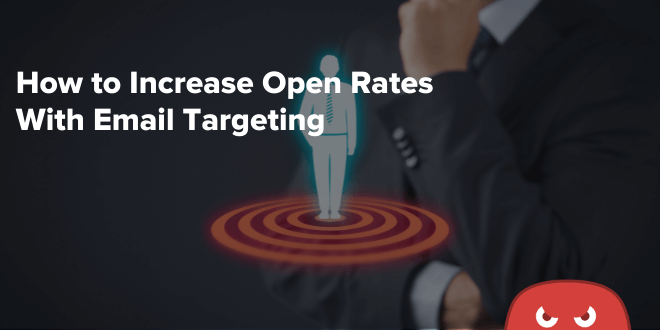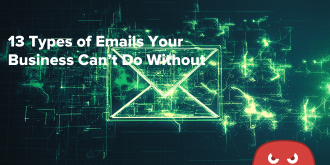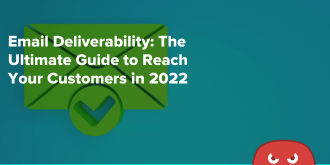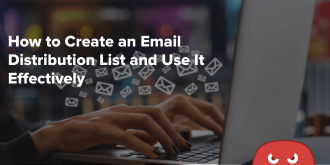Quick Links
Personalization is vital in marketing, with customers expecting brands to treat them as individuals. In a recent survey, 45% of consumers said they were likely to take their business elsewhere if a brand failed to offer a personalized experience.
The same need for personalization applies to email marketing. Marketers have to cater to their specific audiences rather than sending generic, mass emails to everyone on their email list.
Targeted emails enable brands to provide relevant content to their audience, build a relationship with them, and improve brand credibility. This consequently can boost sales.
This article will explain what email targeting is, why marketers need targeted emails, and how you can build a targeted email campaign.
What Is Email Targeting?
Email targeting or targeted email marketing is the practice of sending personalized emails that are relevant to your target audience.
Marketers typically divide their audience into multiple segments based on demographics, buying habits, and other factors, and send emails that resonate with each segment.
Using this method, they ensure that they cater to their readers’ various preferences — so the chances of customers relating to and checking out a brand’s products or services increase greatly.
Email targeting aims to boost conversions, but brands can have smaller goals along the way, such as increasing click-through rates, improving email deliverability, or boosting email subscriber numbers.
Why Is Email Targeting Important?
Email marketing is one of the primary channels for communicating and building relationships with your customers. Here’s why most marketers personalize their email campaigns:
Address different kinds of customers
Brands often think of their customers as a homogeneous unit. Their buyer personas could be as vague as “men aged between 25 to 40 years.” Experienced marketers will know that even within that group, there are tons of different variables that affect purchases: career, interests, marital status, hobbies, location, and more.
Targeted email marketing calls for accurate audience segmentation and enables brands to actually connect with the different types of buyers they are sending emails to.
Address customers in various buyer lifecycle stages
You don’t want to send an introduction email to someone that has already completed multiple orders. It doesn’t make sense from the customer’s point of view.
With targeted email marketing, you can send the right messages to audiences in different stages of the buyer journey, be it a prospect, a lead, or a repeat customer.
Improve credibility
Sending poorly-crafted and generic emails to your subscribers ensures they don’t trust your brand, mark your emails as spam, and decreases any chances of a successful email marketing campaign.
But, with targeted emails, you can ensure that most of your subscribers are interested in what you’re sending to their email addresses. This builds credibility and brand reputation. So, even if they don’t make immediate purchases, they’ll continue to engage with your brand long-term.
Boost click-through rates
The average click-through rate across all industries is around 2.13%. While many factors affect this metric, targeted emails can encourage users to open the links in your email.
Email targeting ensures the links you send to different readers are of interest to them. For example, sending a limited-time offer to a buyer with multiple items saved on their wishlist can entice them to click through to claim the offer and complete the purchase.
Build customer relationships
Targeted emails help build a rapport with customers where they open and read what you’re sending, be it informative articles, discounts, or company updates.
Sending customers the right content at the right time builds trust. This trust is crucial for building and maintaining customer loyalty.
Better customer retention
All of the above factors keep customers coming back for more. When your email campaigns are targeted to address your audience’s specific needs, it shows you know what you’re doing.
Increased rapport and credibility make readers more willing to give your products or services a chance. One successful order and more great emails later, you have a repeat customer that believes in your brand.
How to Create an Effective Targeted Email Marketing Campaign
So, now that you know why you need to personalize your emails let’s focus on the how. Here is a 6-step guide to get you started:
#1. Collect the right data
To set up the foundation of a targeted email marketing campaign, you need to collect the right data sets. Typically, the data you collect will be a mix of general customer information and more detailed statistics about their buying habits.
Many brands struggle with data collection, with 43% admitting that getting accurate customer data for personalization is challenging.
You can set up data collection via forms and surveys in emails, use tracking pixels on your website or eCommerce store, or set up social media listening.
You can also host contests or giveaways, where customers fill out a basic information form to enter the competition. You can also regularly send feedback surveys to current customers.
If you’re just starting out, then competitor analysis is also a great avenue. Analyzing the top performers in your niche and seeing who their customers are and how they behave can help you better understand your target audience.
The real trick here is to unify all these various data sources into a single email marketing platform or CRM that supports email automation and advanced personalizations.
CTA: Need some help figuring out your email marketing strategy? Schedule a free call with our digital marketing specialists today.
#2. Use data for audience segmentation
The first set of data you need is demographics — your customers’ average age, location, income, education level, gender, etc.
Then, you dive in deeper to understand their interests, the devices they prefer to shop on, when they’re more likely to open your emails, and the types of emails they like.
All of this data is combined to construct a buyer persona, a fictional customer that represents a group of buyers. So, for example, you can have a buyer persona representing “high-earning married women over 30”.
Most marketers create multiple personas for each section of their customer base. Once these personas are built, it’s easier to understand audience pain points and create content to address them.
The goal of audience segmentation is to create multiple versions of the same emails so that they appeal to a majority of your subscribers.
For example, office supplies and furniture brand Poppin segments emails by the income and tastes of their audience.
Here’s their email for the “$75 essentials”:
And their email for “$500 essentials”:
While the layout for both emails is the same, the language used is different. The first focuses on functionality and affordability, while the second is focused on helping customers build their dream work-from-home setup.
#3. Create relevant content for each segment
Content for marketing campaigns is based on keyword research, market research, the target audience, and overall content marketing goals.
You can use different types of emails across the customer journey to build relationships with new leads and repeat customers alike.
GetResponse estimates that triggered automated emails have the highest open rates.
Automated emails, such as an abandoned cart or transactional ones, are personalized automatically, with the user’s added products or preferences. However, marketers send many other types of emails, including:
- Newsletters: A weekly or monthly newsletter with personalized content.
- Promotional emails: Emails with relevant offers to a specific audience segment.
- Informational emails: Company updates, product updates, etc.
- Feedback: Asking customers for feedback about a particular service or the entire company.
All of these emails must be crafted with the target audience in mind. For example, promotional offers for slim-fit skinny jeans may not be ideal for audience members over 50. Promotions geared towards older groups should feature language and items they will be interested in.
#4. Test your campaign
Before fully launching your campaign, test the emails to see if they work on every major device and resonate with the target audience.
Your emails need to look good on desktops, mobiles, and tablets while maintaining formatting and design.
A/B testing is the ideal method to test email layouts on multiple devices. In an A/B test, you create two versions of the same email and send each version to different subsets of your audience.
Each version can have different names, subject lines, preview text, body copy, images, and call-to-action buttons.
Track each version to measure relevant metrics. For example, if the goal of your email marketing campaign is to boost email marketing revenue, then click-through rates via the CTA buttons are what you need to compare.
Testing can also determine ideal email frequency, which days of the week have the best open and click-through rates, and more.
Test your emails before and during a marketing campaign to identify opportunities for optimization.
#5. Choose a powerful email marketing platform
An effective email marketing campaign requires the correct tools. You need software that helps you with research, email creation, distribution, automation, testing, and analytics at scale.
You can use all-in-one platforms like MailChimp, Litmus, or HubSpot to manage every element in a single place or rely on standalone tools that perform one function but do it really well. MailGenius, for example, is a free tool that analyzes your email for possible triggers that could send it to the spam folder.
If you’re not sure about your writing skills, you can outsource the copywriting to web content experts.
If you’re using an all-in-one platform, ensure it has integration and automation capabilities. Automation speeds up marketing campaigns by relieving marketers of repetitive, mundane work.
Triggered welcome and transactional emails are examples of how automation can help streamline your email marketing.
According to BlueShift, email triggers lead to a 468% higher click rate and a 525% higher conversion rate.
#6. Monitor and optimize
Monitor your email marketing campaign to ensure you’re effectively targeting your audience.
Performance metrics like overall open rate and click-through rate can be helpful to measure progress towards the broader campaign goals, but you also need to see if your targeted emails are working.
If the emails you’re sending to a specific subset of your audience fail, then A/B testing should help you figure out the difference between the multiple versions and help you understand why metrics aren’t up to the mark.
In many cases, your open rates could be great, but click-through and conversion rates could be lower. In the first scenario, it indicates customers want to see content from your brand, but the content they’re seeing is not persuading them to make a purchase or visit your website.
Measuring conversion rates is more complicated since it also depends on each product, its pricing, and other external factors like shipping time or cost.
Based on A/B testing and performance metrics, you must optimize your campaign content and then test again to measure effectiveness.
Grow Your Customer Base and Increase Profits with Targeted Email Marketing
Email targeting is an effective way to boost email marketing revenue and profit. If done right, your emails will leave a happy impression on your audiences, build credibility, and encourage customer loyalty.
Of course, if you’ve got no one on your email list, that’s a different problem altogether. The HOTH’s marketing experts can help you create targeted SEO and PPC campaigns and high-converting landing pages to build your lists more effectively.
















I’m really satisfied about your manner of communicatiing this important aspect of Email Targeting.
After reading this article, I sincerely declare that I won’t ignore the core web vitals.
Your blog was too good. I really appreciate with your blog.Thanks for sharing.